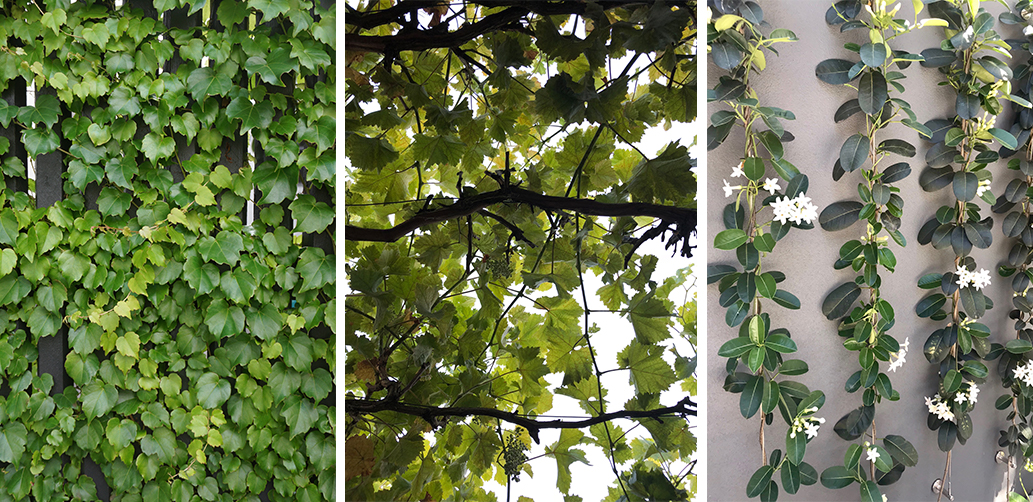
05 Apr Just Keep Climbing
Creepers, climbers, vines- call them what you will. They are members of a group of plants that offers enormous versatility. Twining, scrambling, attaching by tendrils or sticky feet, these plants have a variety of techniques for moving upwards and outwards. In fact they can be great ‘problem solvers’ in a multitude of landscape situations.
Climbers can be useful in landscapes of all sizes. In smaller areas they can be effective in delivering greenery and softness without relinquishing square meterage. There is enormous diversity available in foliage, colour and flower available through countless species and cultivated varieties. A well-chosen climber for a situation can become a wonderful backdrop, or a striking feature in its own right.
Working through the desired effect in a particular landscape scenario – and understanding the growth habit and maintenance requirements needed – will help point to the best options available for selecting a climbing plant species.
Softening structures and shade
Climbers can be excellent at softening structures such as pergolas and screens. As well as that they can be used with vertical wires to become a ‘living’ installation. Species can be evergreen, semi deciduous or deciduous.
Many climbers are extremely vigorous so consideration of the intended level of maintenance is an important part of selecting this variety of plant. As a landscape design and horticultural service company we think practically about the landscapes we design and the planting plans we prepare and often challenge clients on their preferred options when we ask them to be realistic about ongoing maintenance- whether they can find the time or are happy to outsource that regular task.
Looking at the 3D imagery prepared for so many new multi-residential developments promoted over recent years, it seems that the new ilk of maintenance gardener will need to be harness-ready and have their ticket to working at heights to train climbers over supporting structures on upper terraces and perilously high rooftops. Even if this direction is to be taken, there are some species that will be far more obliging- and require far less maintenance- than others.
Fast growing deciduous vines are perfect for built structures such as pergolas and arbours. There is enormous joy that comes with sitting beneath cascading vines as you sip on a refreshing libation in the height of summer. Deciduous vines make good sense: if the pergola is attached to the house it means then that the interior enjoys a great deal more natural light in the darkest and coldest time of the year. The enjoyment of the winter sun should note be overlooked- something we need to remind our clients of especially when they live in Melbourne!
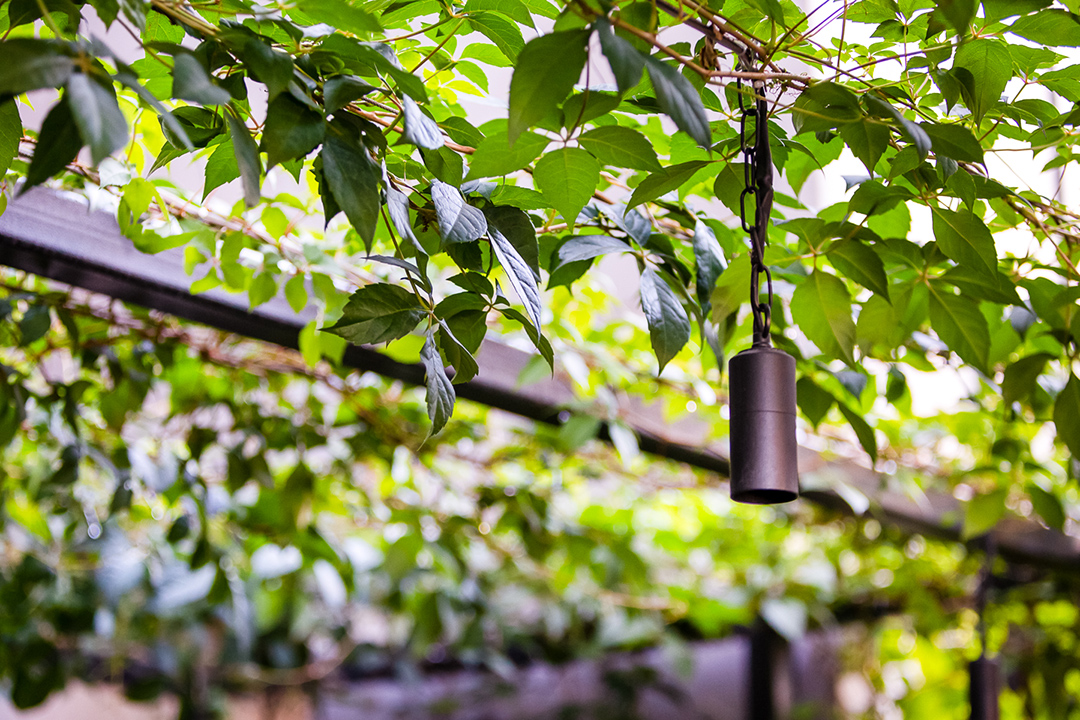
Virginia creeper (Parthenocissus quinquefolia) can bring about a heavenly draped greenery effect on a pergola without losing the overall line of the pergola structure itself.
We love to use edible plants including real grapes- on a pergola- as shown in the image below. Reclining beneath foliage and generous clusters of grapes above you can be quite magical…and in this scenario you could be forgiven for wondering where the eunuch might be.
In our design work we have also trialled using kiwi fruit (Actinidia deliciosa- one of each of a male and female vine are required to produce fruit) with its heavenly foliage though we have had less success with this plant on pergola structures overall mainly due to greedy possums.
Vim and Vigour
Climbing plants can be characterised by the way they grow.
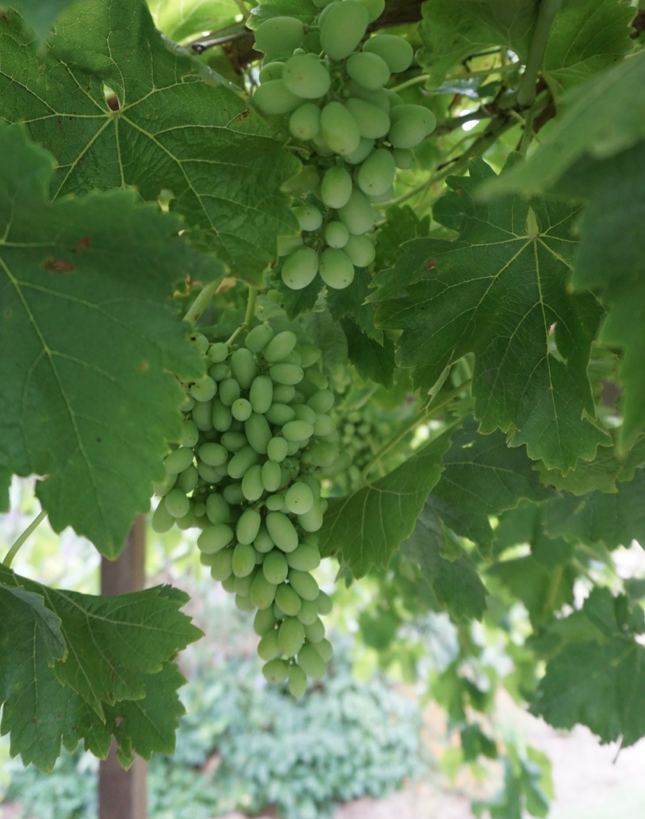
As a twiner, Wisteria will take hold on a wire or post with its strong flexible stems. There is the most splendid Wisteria planting in the Yarra Valley at Alowyn Gardens. The cultivar used in this garden is the stunning ‘Macrobotrys’ with its racemes (or flower stems) that are more than a metre in length. Clearly this cultivar is not appropriate in a scenario where there overhead structure is too small or too low.
Don’t be seduced by the beguiling flowers of Wisteria though if you’re not in for the maintenance long haul. I have seen Wisteria specimens that you could blame for climbing beneath window frames with the intent of strangling you in your sleep such is the potential vigour of this plant.
Unsure if the Wisteria is Chinese or Japanese in origin? You need only look at the direction of the stem up the supporting structure: the vines of Japanese wisteria grow clockwise on its support- whilst Chinese wisteria grows anti-clockwise.
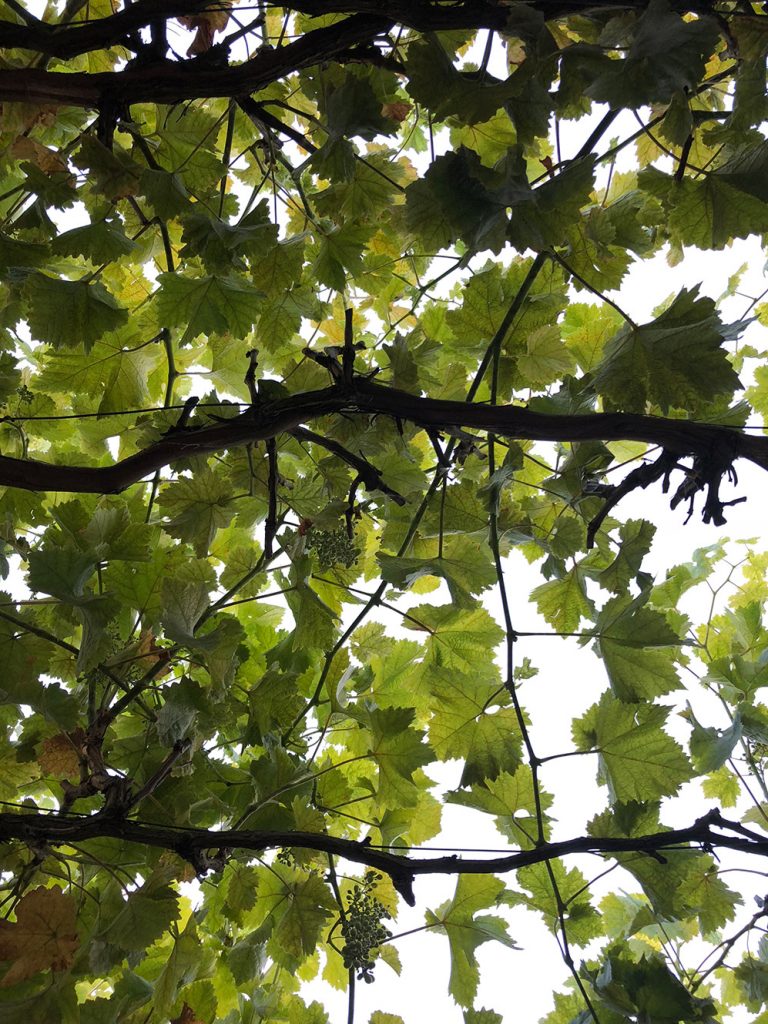
Similarly the ornamental grapevine (Vitis cognetiae) is also a stunning and super fast grower that can be trained very effectively along a verandah or fascia of a building to create instant shade and greenery to the interior. It does though need to assistance being trained along the wire frequently but might be a far more attractive and softer effect than an awning and also allows the winter sunlight through once the leaves have dropped in autumn.
Meshed
Understanding the growth habit of a plant will help drive the design of the plant support.
Using farm mesh or reinforced sheets of mesh (reo) attached to hardwood posts becomes a great backdrop to an evergreen vine. Chinese star jasmine (Trachelospermum jasminoides) is a great species for creating a solid wall of green regardless of the amount of sun. Growth rates will differ depending on the amount of direct sunlight. Regular clipping of the new growth will bring about more foliage and ensure that a flat wall of green is created in time.
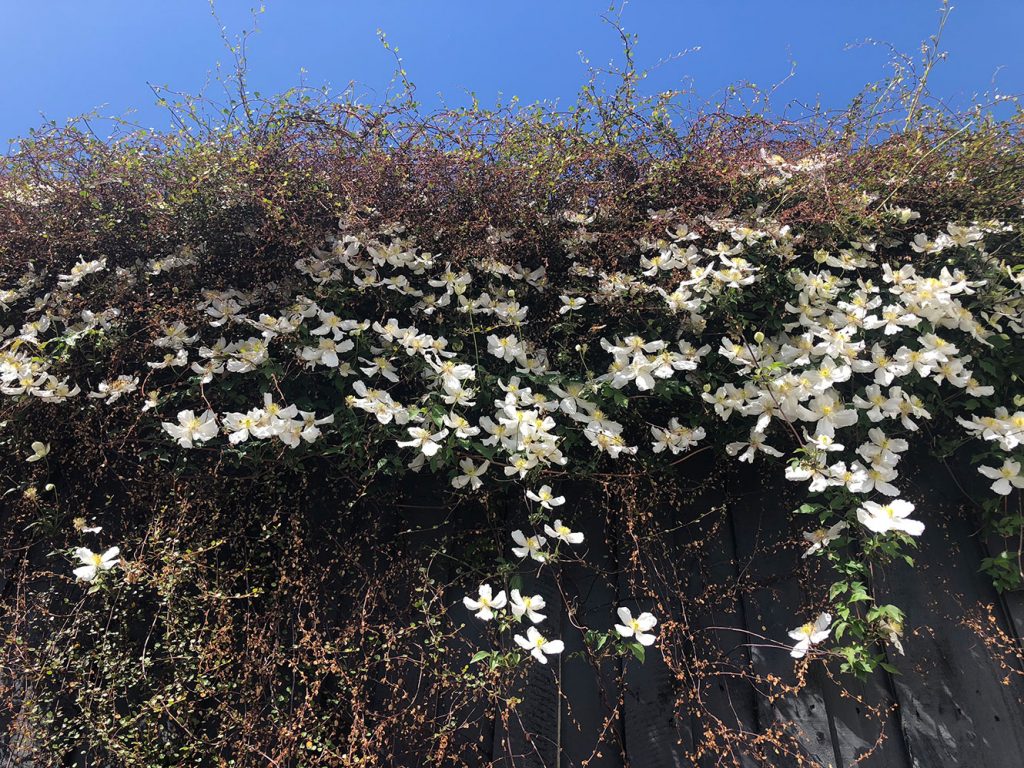
Cyclone fencing can be screened fabulously well with the Creeping Wire Vine native to New Zealand (Muhlenbeckia complexa). This is great around tennis courts and similar scenarios. This plant is a bone of contention in our design studio (personally I love this but others do not) with the effect of a bronzed backdrop to the greenery in front. You might also also refer to our Work Portfolio to see more images of this vine used as boundary screening particularly in “Front Garden Journey”.
In my opinion Muhlenbeckia can become a springboard for illuminating and highlighting other species including other climbers that can grow with nonchalance through the maindenhair vine. Examples of this include a heavenly Clematis or one of my drop dead all time favourites – the Chocolate Vine (Akebia quinata) which grows up the tower at Sissinghurst.
If an edible garden is your thing then passionfruit (Passiflora edulis) offers a brilliant solution. If the lower part of the fence is in shade or has limited sun you are unlikely to have a full fence of green- which may not be an issue if the placement is not in a high traffic area. The flowers of passionfruit are stunning and the vigour of the plant will mean that maintenance is key. Keep in mind that the lifespan of species is around the seven year mark.
Home grown options
There is a number of Australian natives that also invite consideration including the Sun Vine (Aphanopetalum resinosum) that is native to Western Australia. This is an underutilised plant that seems to appear even slightly glaucous in some light. This vine has creamy yellow flowers that are not terribly significant though its effect en masse can certainly be striking. This is a most obliging plant that deserves wider use.
The Wonga Wonga Vine (Pandorea pandorana) is native to Australia and belongs to the plant family Bignoniaceae. I can still remember this plant from my days at Burnley when the only way I eventually rote learned this for exams was from word association. Once the memorable ‘Golden Showers’ cultivar was appended the associated words wove a story of a porn movie. But let me stop right there. The flower colours of some of the cultivars are not to everyone’s taste but the creamy yellow flowers of the species are quite lovely and arguably holds broader appeal.
Common mistakes with climbers
A common mistake that we see in gardens is the installation of multiple horizontal stainless steel wires to support Chinese Star Jasmine (Trachelospermum jasminoides). It is difficult to create a flat wall of green with this approach as there is a birds-nest effect as the plant stems need to be pulled up and trained onto the next wire. The more effective (and cost effective) way to go is to use mesh or reinforced mesh sheets on posts to create a flat wall of green in time. Some of our clients don’t like the raw mesh so painting or powder-coating the sheets will bring visual relief until the surface is fully covered.
Another blunder that is commonly made is that sun loving plants are trained up the southern side of a northern boundary to create greenery along the top of the fence- only to then defoliate and look scrappy at eye level where the vertical stem is in shade. Sometimes in our planting plans when we want a specific vine at the top of the fence this effect is countered with appropriate evergreen planting in front of the fence and defoliated vine. An excellent example of a vine that can be used in this way is the much under-utilised Lemon-Scented Jasmine (Jasminum azoricum). It’s an evergreen climber that will be showy with starry white flowers in spring and then spot flower throughout summer and autumn; sometimes even the spot flowering is a showy display indeed. It can be trained up a vertical stainless steel wire to then be guided along the top of a screen or throughout the lattice panels on the top of a paling fence.
Scramblers
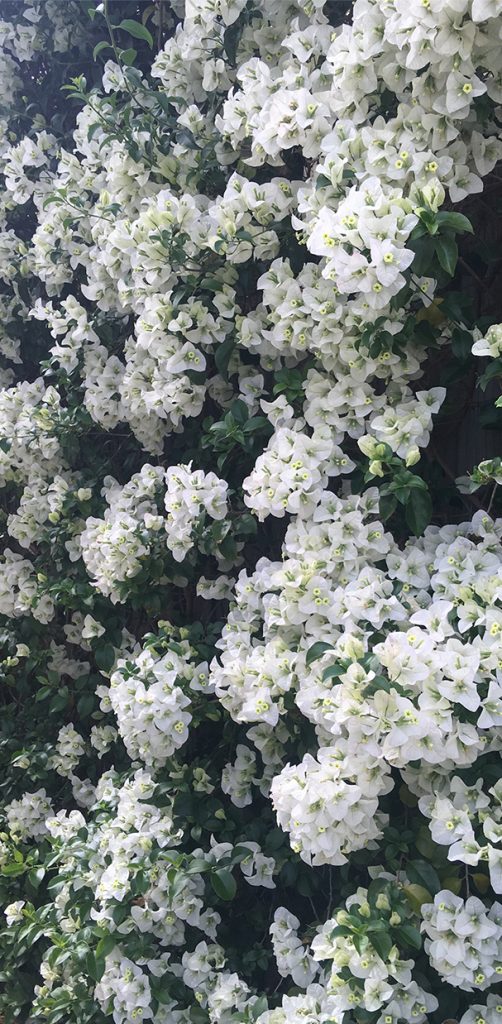
Scramblers are plants such as bougainvillea that have thorns or spikes that take a hold of a support. Bougainvillea can be a heavenly plant that has different flowering duration in different climates around the country. This plant can also provide- with time- an additional half metre in additional screening above the finished height of a fence or screen. In Melbourne we can enjoy six and sometimes even up to seven months of floral display of this blousy and voluminous creature. I like in particular the white flowering variety (Bougainvillea ‘White Cascade’) which can also be a contender for consideration in more traditional gardens or at least where a more conservative green and white plant palette is sought.
Vertical garden
The focus on and development of vertical gardens over the last ten years has been considerable. We are often approached by clients keen to explore the idea of having a vertical pocket garden system installed. Often when they learn the costs of not just the initial installation but the ongoing need to replace plants through natural senescence, we will steer them towards appropriate climbers instead. A wall of Boston Ivy (Parthenocissus tricuspidata) requires the tiniest investment with relatively very fast results compared with the outlay, growing on and maintenance of a full modular vertical garden pocket system.
Self adhering
Some climbers have ‘sticky feet’ such as Creeping Fig (Ficus pumila). This plant can be very effective in creating an evergreen backdrop in a garden. It can be used on painted cement sheeting to create a solid backdrop of greenery in less time you would think. Its tiny suction cups should not be used on damaged brickwork or mortar if there is concern about the mortar becoming more unstable with time.
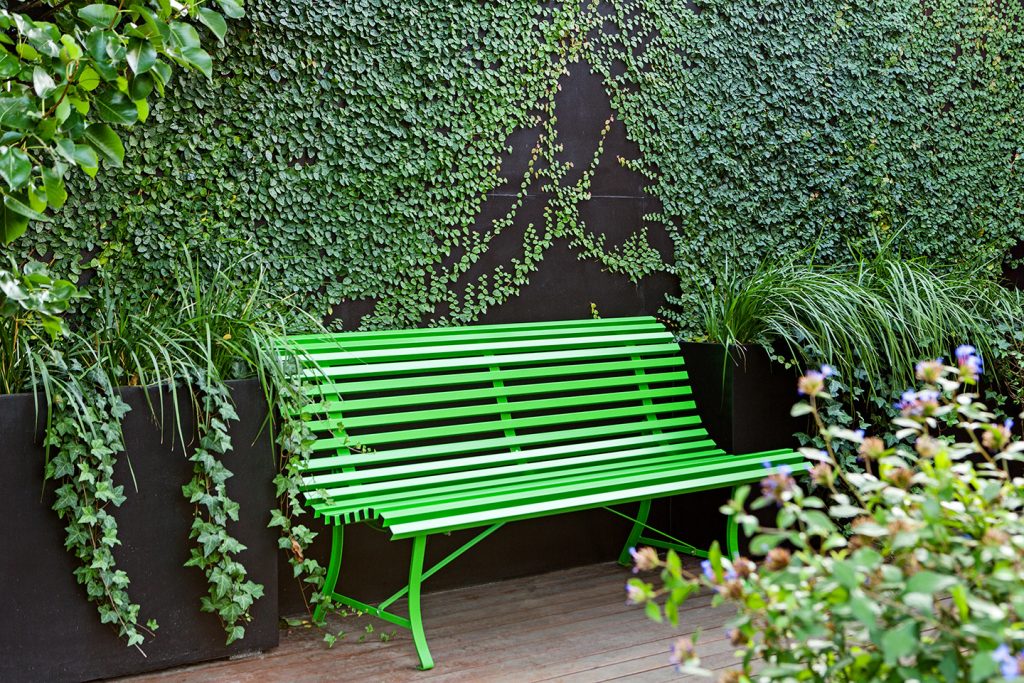
When this climber is not maintained it will grow out of the wall and the adult leaves become somewhat unattractive. The key to the success of this climber is regular clipping and maintenance- and let’s dispel the myth that this species is slow growing- because quite simply it’s not. Occasionally on planting the plant can have a tendency to sulk for a period of time before taking off with haste.
Whenever I see an older Ficus pumila where the branches have ‘unstuck’ and the plant is merely self supporting itself off the wall, it can indicate that it’s time for a brutal prune to recreate the initial intended effect of a flat wall of green. There is also Ficus pumila ‘Minima’ which is slower growing and as its name suggests has a smaller leaf and just perfect for certain situations.
The climbers in the Parthenocissus genus including the wonderful Silver Vein Creeper (Parthenocisuss henryana) which has the most beguiling foliage. Each Parthenocisuss climber species has varying levels of adherence and vigour. Some are far better suited to some surfaces than others.
Deservedly prosaic, fabulous Boston ivy (Pathenocissus tricuspidata) has an ability to grow extremely quickly in a multitude of situations. We like to loosen up screens by growing a vine onto a fence. The effect can be wonderful and somewhat unstructured- and in winter the tracery of the stems become a cobweb of interest in itself.
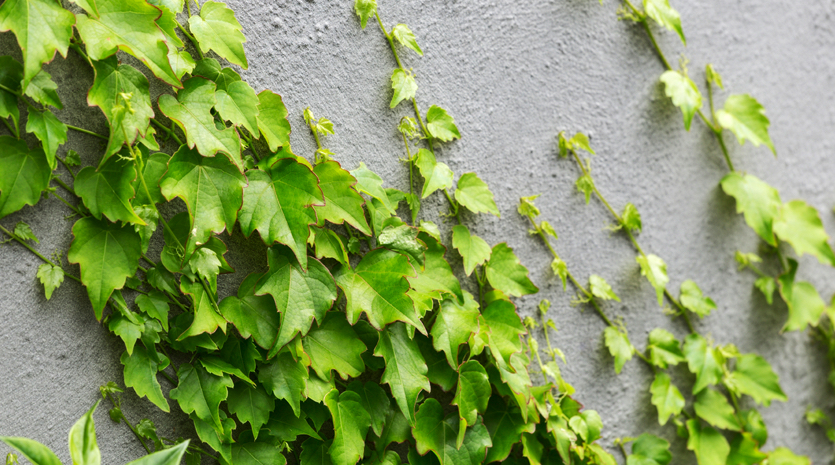
Small Leaf Boston Ivy (Parthenocisuss quinquefolia ‘Lowii’) possesses smaller leaves as indicated by its common name and does not possess the vigour of the straight species. It showcases lovely subtly ruffled foliage.
Then there is the stunning Japanese Hydrangea Vine (Schizophragma hydrangeoides) with its self adhering aerial roots that is utterly perfect for the southern or easterly side of a brick wall or building. It can also be used to train up the trunks of old trees.
Changing it up
Sometimes its possible to train a clinber in a non-traditional way. For example in a recent project we used Virginia Creeper (Parthenocissus quinquefolia). They were installed on a brick wall on the vertical plane, and separate wires were attached between the brick wall and the fascia of the house. The maintenance in this approach is critical as the vines can join up and even run amok on the wall itself.
The beauty of this approach is that it’s super fast growing and the folded wires have created the lightest weight and seemingly invisible pergola-esque structure to allow for winter light. The cost of installation is also very low considering that there is no need for pergola posts and supports and it can be done – contingent on situation- without the services of a registered landscape building contractor and building permit.
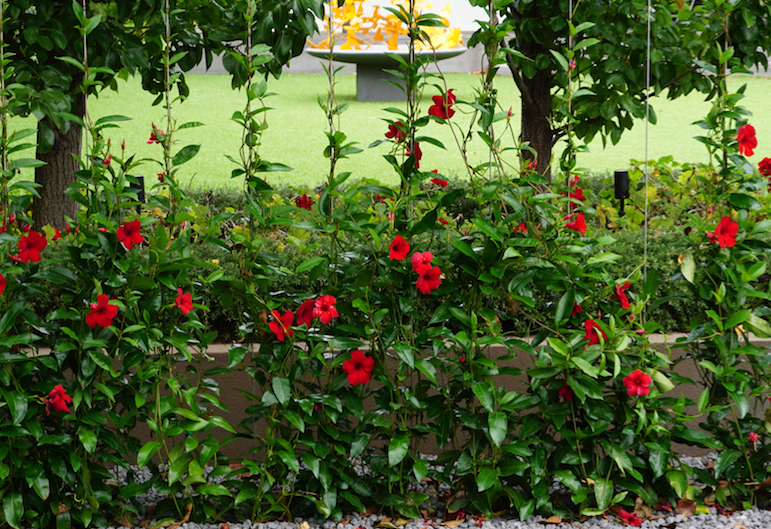
In our design studio we also love to use beautiful vines as a striking wall installation or ‘room divider’. We’ve enclosed the ends of pergolas with vines such as in the photo here using red Mandevillea. In many other scenarios we’ve used different Mandevillea sp, Hoya sp, Hardenbergia sp, as well as the heavenly Madagascan Jasmine (Stephanotis floribunda) on wire systems including to the excellent wire systems available through Ronstan Tensile Architecture. The wire spacing, the surface to be attached to and the plant species needs to be carefully worked through in each situation.
The planting of a different and unusual plant can also create a stunning effect. Snail Creeper or Corkscrew Vine (Vigna caracella syn. Cochliasanthus caracalla) was- quite interestingly – one of Thomas Jefferson’s favourite plants. This botanical curiosity can be quite spectacular. The plant will thrive in the heat, and tends to throw out a great deal of flowers towards the end of summer and early autumn. The vine will be semi deciduous or deciduous depending on the climate.
Finally…
The particular ‘look’ that is sought, the supporting structure on hand or to be created, the amount of sunlight and the desired level of maintenance will all combine to help distil the best options available in climbing plants for a particular situation.
Written by Lisa Ellis
Banner image- climbers from left to right: Boston Ivy (Parthenocissus tricuspidata), Grapevine (Vitis vinifera), Madagascan Jasmine (Stephanotis floribunda)


